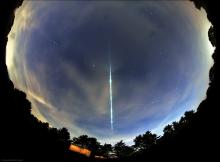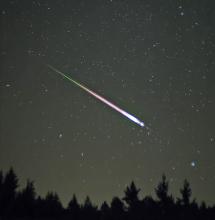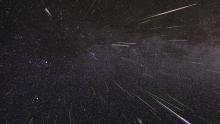Listen to today's episode of StarDate on the web the same day it airs in high-quality streaming audio without any extra ads or announcements. Choose a $8 one-month pass, or listen every day for a year for just $30.
You are here
Geminid Shower
In the 1860s, a new meteor shower began to punctuate the December sky. And for more than a century afterwards, it got better and better. Now, it’s become the most reliable shower of the year.
The Geminid shower is at its best the next couple of nights. At its peak, it should produce a hundred or so meteors per hour. The Moon is in view for most of the night. But it sets early enough to provide a few good hours of meteor watching.
Geminid meteors are bits of dust from an asteroid. The dust grains spread out along the asteroid’s orbit. Earth intersects this path every December, so some of the grains ram into the upper atmosphere. They quickly vaporize, forming the glowing streaks of light known as meteors or shooting stars.
The path didn’t begin to intersect Earth’s orbit until the 1800s, so the Geminid shower is the youngest of all the big meteor showers. The rate of visible meteors has increased since its discovery. That’s because the gravity of Earth and Jupiter have shifted the path of the dust grains. Earth now plows more directly through that path — turning the Geminids into the year’s best meteor shower.
Look for the shower beginning in mid- to late evening. It usually produces a few especially bright meteors, so it’s worth a look even through the moonlight. And although its peak is brief, it can produce the odd bright meteor for a night or two after the peak — extra time to catch the fireworks.
Script by Damond Benningfield





